Christopher McGillicuddy
- Problem Set #1
|
Part 1
|
 p1.dbn p1.dbn |
paper 80
pen 18
line 85 25 15 55
|
| |
Create a program to draw a carefully chosen one line on a paper of your choice.
|
Part 2
|
 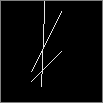 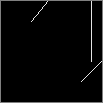 p2.dbn p2.dbn |
// type program here
set a 80
paper 100
pen 10
line a 20 (a*2) (a+20)
line (a+10) (a/2) 80 (a*(a+4))
line 30 a (a*2) (a*3)
|
| |
Create a program that uses one variable as a means to control a set of 3 lines. Capture 3 instances of the graphic (A,B,C).
|
Part 3
|
 p3.dbn p3.dbn |
paper 30
pen 100
repeat A 40 90
{
line 20 A 40 A
}
|
| |
Create a program to draw a single filled rectangle. Again, choose carefully.
|
Part 4
|
 p4.dbn p4.dbn |
paper 88
pen 3
repeat b 20 90
{
line 30 b 80 90
}
|
| |
Create a program to draw a single filled triangle. Use your good judgement.
|
Part 5
|
 p5.dbn p5.dbn |
paper 100
repeat a 5 99
{
pen a
line a a 40 20
}
|
| |
Think of all the ways you can draw a filled triangle, and choose one. Utilize the properties of the drawing method you choose, to create a single filled triangle.
|
Part 6
|
 p6.dbn p6.dbn |
paper 100
set [20 20] 58
set [25 80] 1
set [35 20] 58
set [40 20] 58
set [30 20] 58
|
| |
Set 5 dots on a paper of your choice. Evoke an emotion with your choice in placement of dots.
|
Part 7
|
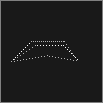 p7.dbn p7.dbn |
//banana
paper 90
Repeat x 0 8
{
Set [((3*x)+10)(40+(2*x))] 30
}
Repeat x 0 10
{
Set [(10+(2*x))(40+(2*x))] 1
}
Repeat x 0 16
{
Set [(30+(2*x))60] 30
}
Repeat x 0 8
{
Set [(36+(3*x))56] 1
}
Repeat x 0 12
{
Set [(10+(3*x))(38+((x/2)+2))] 30
}
Repeat x 0 7
{
Set [(62+(2*x))(56-(2*x))] 1
}
Repeat x 0 5
{
Set [(63+(2*x))(60-(3*x))] 30
}
Repeat x 0 9
{
Set [(48+(3*x))(45-(x/2))] 30
}
|
| |
Create a representational picture (i.e. something that looks like something) using just 8 (at maximum) dotted lines.
|
Part 8
|
 p8.dbn p8.dbn |
paper 1
repeat a 1 5
{
repeat b 0 20
{
repeat x 0 100
{
set [(a*b) ((x*a)+a)] x
}
}
}
|
| |
Using a nested loop, fill the entire field with the value of some calculation that can be appreciated. Do not use the Line command.
|
Part 9
|
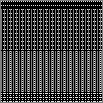 p9.dbn p9.dbn |
paper 100
repeat x 0 100
{
repeat y 0 30
{
set [(x*2) (y*4)] 10
set [(x*3) (y*2)] 10
}
}
repeat x 0 60
{
repeat y 60 100
{
set [(x*2) (y-50)] 50
set [(x*3) (y-8)] 50
}
}
|
| |
Using a nested loop, create a stippled pattern of dots that can be enjoyed for its complexity. Do not use the Line command.
|
Part 10
|
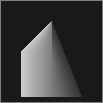 p10.dbn p10.dbn |
paper 90
repeat x 20 50
{
pen x
line x 5 x 50
}
repeat x 50 80
{
pen x
line x 5 50 x
}
repeat a 20 50
{
pen a
line 50 80 a 50
}
|
| |
Using the Line command, and a (few) nested loop, create an image that evokes a three-dimensional feeling through shading.
|
 p1.dbn
p1.dbn 

 p2.dbn
p2.dbn  p3.dbn
p3.dbn  p4.dbn
p4.dbn  p5.dbn
p5.dbn  p6.dbn
p6.dbn  p7.dbn
p7.dbn  p8.dbn
p8.dbn  p9.dbn
p9.dbn  p10.dbn
p10.dbn